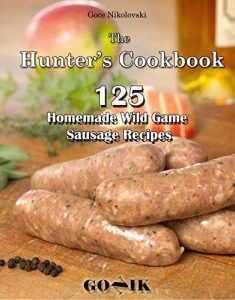Every ethical hunter wants to make good use of any game that he is fortunate enough to bring home. Turning his (or her) hard earned harvest into sausage is one of the best ways to make sure that gets done.
Making sausage at home is one of those lost arts that really is not so difficult as it sounds. At its core, a sausage is simply ground meat and fat, salt, and flavorings. It really is not much more involved than grinding your own hamburger; you don’t even have to stuff it into links if you don’t want to. Yet the flavor of a well-made link surpasses the sum of its parts, and a truly great sausage is fit to be served as a main course at a fancy dinner.
Good sausage is all about balance. Balance of salt and savory, balance of meat and fat, balance of spices and herbs within the whole. Knowing a proper ratio of salt to meat (and fat) is essential, but once you understand it you can adjust to your own perception of saltiness, which varies wildly among people. Some sort of liquid helps tighten the bind when you mix the sausage meat; and without this bind you have hamburger, not sausage. You also need a proper amount of fat, at least 20 percent – I have not yet met a low-fat sausage worth eating.
But beyond those “rules,” your ingredient list is limited only by your imagination. You can toss in as many or as few herbs and spices and other flavorings as you’d like.
It isn't any harder to make sausage from venison (or other game meat) than it is to make it from more common ingredients.
Any sausage that you normally make from pork or beef (or other domestic meat) can be made with venison. Semi-dry and dry recipes are also easily adapted for venison and other game. As a matter of fact, some of the best salami I ever made was from a mixture of elk and deer meat.
Don't let the idea of making sausage from venison scare you. As long as you watch the fat content and spice mixtures as shown in the recipes here, you shouldn't have any difficulty.
In this book, you will find 125 homemade wild game sausage recipes in all its forms and functions, for serving it in everything from basic breakfast to gourmet meal.
Making sausage at home is one of those lost arts that really is not so difficult as it sounds. At its core, a sausage is simply ground meat and fat, salt, and flavorings. It really is not much more involved than grinding your own hamburger; you don’t even have to stuff it into links if you don’t want to. Yet the flavor of a well-made link surpasses the sum of its parts, and a truly great sausage is fit to be served as a main course at a fancy dinner.
Good sausage is all about balance. Balance of salt and savory, balance of meat and fat, balance of spices and herbs within the whole. Knowing a proper ratio of salt to meat (and fat) is essential, but once you understand it you can adjust to your own perception of saltiness, which varies wildly among people. Some sort of liquid helps tighten the bind when you mix the sausage meat; and without this bind you have hamburger, not sausage. You also need a proper amount of fat, at least 20 percent – I have not yet met a low-fat sausage worth eating.
But beyond those “rules,” your ingredient list is limited only by your imagination. You can toss in as many or as few herbs and spices and other flavorings as you’d like.
It isn't any harder to make sausage from venison (or other game meat) than it is to make it from more common ingredients.
Any sausage that you normally make from pork or beef (or other domestic meat) can be made with venison. Semi-dry and dry recipes are also easily adapted for venison and other game. As a matter of fact, some of the best salami I ever made was from a mixture of elk and deer meat.
Don't let the idea of making sausage from venison scare you. As long as you watch the fat content and spice mixtures as shown in the recipes here, you shouldn't have any difficulty.
In this book, you will find 125 homemade wild game sausage recipes in all its forms and functions, for serving it in everything from basic breakfast to gourmet meal.






